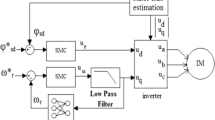Abstract
This study applies the sliding mode control technique to control the three-phase induction motor under magnetic saturation. Based on the field-oriented control technique, the proposed sliding mode controller is decoupled into two independent controllers for the stator flux and rotor speed. In addition, the sliding surface and reaching laws are improved to be able to increase the convergence rate and reduce discontinuity phenomena. The simulation and experimental results of the three-phase 1-hp induction motor in magnetic saturation mode will be addressed clearly to show the effectiveness and stability of the proposed control method in ensuring that the motor torque exceeds 5× the rated value.


















Similar content being viewed by others
Availability of data and materials
Not applicable.
Code Availability
Not applicable.
Abbreviations
- \(u_{sq} ,u_{sd}\) :
-
Stator voltages (d–q axis)
- \(u_{rq} ,u_{rd}\) :
-
Rotor voltages (d–q axis)
- \(i_{sq} ,i_{sd}\) :
-
Stator currents (d–q axis)
- \(i_{rq} ,i_{rd}\) :
-
Rotor currents (d–q axis)
- \(\varphi_{sq} ,\varphi_{sd}\) :
-
Stator fluxes (d–q axis)
- \(\varphi_{rq} ,\varphi_{rd}\) :
-
Rotor fluxes (d–q axis)
- \(\omega_{r}\) :
-
Angular velocity
- \(R_{{\text{s}}} ,R_{{\text{r}}}\) :
-
Stator, rotor resistances
- \(L_{{\text{s}}} ,L_{{\text{r}}} ,L_{{\text{l}}}\) :
-
Stator, rotor, mutual inductances
- \(T_{{\text{e}}} ,T_{{\text{m}}}\) :
-
Electromagnetic, load torques
- \(p\) :
-
Pole-pairs
- \(B\) :
-
Friction coefficient
- \(J\) :
-
Inertia constant
References
Costa BLG, Graciola CL, Angelico BA, Goedtel A, Castoldi MF, Pereira WCA (2019) A practical framework for tuning DTC-SVM drive of three-phase induction motors. Control Eng Pract 88:119–127
Hajary A, Kianinezhad R, Seifossadat SG, Mortazavi SS, Saffarian A (2019) Detection and localization of open-phase fault in three-phase induction motor drives using second order rotational park transformation. IEEE Trans Power Electron 34(11):11241–11252
Shi S, Sun Y, Dan H et al (2020) A general closed-loop power-decoupling control for reduced-switch converter-fed IM drives. Electr Eng 102:2423–2433
Sullivan CR, Sanders SR (1995) Models for induction machines with magnetic saturation of the main flux path. IEEE Trans Ind Appl 31(4):907–917
Sullivan CR, Kao C, Acker BM, Sanders SR (1996) Control systems for induction machines with magnetic saturation. IEEE Trans Industr Electron 43(1):143–152
Djellouli T, Moulahoum S, Boucherit MS, Kabache N (2011) Speed and flux estimation by extended Kalman filter for sensorless direct torque control of saturated induction machine, In: 2011 international siberian conference on control and communications (SIBCON), Krasnoyarsk, Russia, pp 23–26
Accetta A, Alonge F, Cirrincione M, Pucci M, Sferlazza A (2016) Feedback linearizing control of induction motor considering magnetic saturation effects. IEEE Trans Ind Appl 52(6):4843–4854
Mousavi MS, Davari SA (2018) A novel maximum torque per ampere and active disturbance rejection control considering core saturation for induction motor, In: 2018 9th annual power electronics, drives systems and technologies conference (PEDSTC), Tehran, Iran, pp 318–323
Fatamou H, Yves EJ, Duckler KFE (2020) Optimization of sensorless field-oriented control of an induction motor taking into account of magnetic saturation. Int J Dyn Control 8:229–242
Accetta A, Alonge F, Cirrincione M, D’Ippolito F, Pucci M, Sferlazza A (2020) GA-based off-line parameter estimation of the induction motor model including magnetic saturation and iron losses. IEEE Open J Ind Appl 1:135–147
Hung JY, Gao W, Hung JC (1993) Variable structure control: a survey. IEEE Trans Industr Electron 40(1):2–22
Utkin VI (1997) Variable structure systems with sliding modes. IEEE Trans Autom Control 22(2):212–222
Bartolini G, Ferrara A, Usani E (1998) Chattering avoidance by second-order sliding mode control. Trans Autom Control 43(2):241–246
Wai RJ, Liu WK (2001) Nonlinear decoupled control for linear induction motor servo-drive using the sliding-mode technique. IEE Proc Control Theory Appl 14(3):217–231
Qi L, Shi H (2013) Adaptive position tracking control of permanent magnet synchronous motor based on RBF fast terminal sliding mode control. Neurocomputing 115:23–30
Salih ZH, Gaeid KS, Saghafinia A (2015) Sliding mode control of induction motor with vector control in field weakening. Mod Appl Sci 9(2):276–288
Han SI, Lee JM (2015) Balancing and velocity control of a unicycle robot based on the dynamic model. IEEE Trans Ind Electron 62(1):405–413
Alonge F, Cirrincione M, D’Ippolito F, Pucci M, Sferlazza A (2017) Robust active disturbance rejection control of induction motor systems based on additional sliding-mode component. IEEE Trans Industr Electron 64(7):5608–5621
Quan NV, Long MT (2022) Sensorless sliding mode control method for a three-phase induction motor. Electr Eng 104:3685–3695
Slotine JJE, Li W (1991) Applied nonlinear control. Prentice-Hall, Englewood Cliffs, NJ
Acknowledgements
The authors would like to thank the associate editor and the reviewers for their valuable comments.
Funding
This work was supported by the Ho Chi Minh City University of Technology and Education and the Industrial University of Ho Chi Minh City, Vietnam, under Grant Number 222/QĐ-ĐHCN, 22/02/2023.
Author information
Authors and Affiliations
Contributions
All authors contributed to the study conception and design. Material preparation, data collection and analysis were performed by Dr. Nguyen Vinh Quan and Dr. Mai Thang Long. The first draft of the manuscript was written by Dr. Mai Thang Long and all authors commented on previous versions of the manuscript. All authors read and approved the final manuscript.
Corresponding author
Ethics declarations
Conflict of interest
The authors have no relevant financial or non-financial interests to disclose.
Ethical approval
Approval was granted by the Ho Chi Minh City University of Technology and Education and the Industrial University of Ho Chi Minh City, Vietnam.
Rights and permissions
Springer Nature or its licensor (e.g. a society or other partner) holds exclusive rights to this article under a publishing agreement with the author(s) or other rightsholder(s); author self-archiving of the accepted manuscript version of this article is solely governed by the terms of such publishing agreement and applicable law.
About this article
Cite this article
Quan, N.V., Long, M.T. Sliding mode control method for three-phase induction motor with magnetic saturation. Int. J. Dynam. Control 12, 1522–1532 (2024). https://doi.org/10.1007/s40435-023-01269-4
Received:
Revised:
Accepted:
Published:
Issue Date:
DOI: https://doi.org/10.1007/s40435-023-01269-4




